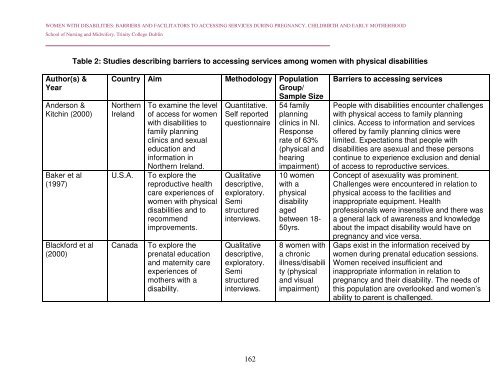Women with Disabilities: Barriers and Facilitators to Accessing ...
Women with Disabilities: Barriers and Facilitators to Accessing ...
Women with Disabilities: Barriers and Facilitators to Accessing ...
You also want an ePaper? Increase the reach of your titles
YUMPU automatically turns print PDFs into web optimized ePapers that Google loves.
WOMEN WITH DISABILITIES: BARRIERS AND FACILITATORS TO ACCESSING SERVICES DURING PREGNANCY, CHILDBIRTH AND EARLY MOTHERHOODSchool of Nursing <strong>and</strong> Midwifery, Trinity College DublinTable 2: Studies describing barriers <strong>to</strong> accessing services among women <strong>with</strong> physical disabilitiesAuthor(s) &YearAnderson &Kitchin (2000)Baker et al(1997)Blackford et al(2000)Country AimNorthernIrel<strong>and</strong>U.S.A.To examine the levelof access for women<strong>with</strong> disabilities <strong>to</strong>family planningclinics <strong>and</strong> sexualeducation <strong>and</strong>information inNorthern Irel<strong>and</strong>.To explore thereproductive healthcare experiences ofwomen <strong>with</strong> physicaldisabilities <strong>and</strong> <strong>to</strong>recommendimprovements.Canada To explore theprenatal education<strong>and</strong> maternity careexperiences ofmothers <strong>with</strong> adisability.Methodology PopulationGroup/Sample SizeQuantitative.Self reportedquestionnaireQualitativedescriptive,explora<strong>to</strong>ry.Semistructuredinterviews.Qualitativedescriptive,explora<strong>to</strong>ry.Semistructuredinterviews.54 familyplanningclinics in NI.Responserate of 63%(physical <strong>and</strong>hearingimpairment)10 women<strong>with</strong> aphysicaldisabilityagedbetween 18-50yrs.8 women <strong>with</strong>a chronicillness/disability (physical<strong>and</strong> visualimpairment)<strong>Barriers</strong> <strong>to</strong> accessing servicesPeople <strong>with</strong> disabilities encounter challenges<strong>with</strong> physical access <strong>to</strong> family planningclinics. Access <strong>to</strong> information <strong>and</strong> servicesoffered by family planning clinics werelimited. Expectations that people <strong>with</strong>disabilities are asexual <strong>and</strong> these personscontinue <strong>to</strong> experience exclusion <strong>and</strong> denialof access <strong>to</strong> reproductive services.Concept of asexuality was prominent.Challenges were encountered in relation <strong>to</strong>physical access <strong>to</strong> the facilities <strong>and</strong>inappropriate equipment. Healthprofessionals were insensitive <strong>and</strong> there wasa general lack of awareness <strong>and</strong> knowledgeabout the impact disability would have onpregnancy <strong>and</strong> vice versa.Gaps exist in the information received bywomen during prenatal education sessions.<strong>Women</strong> received insufficient <strong>and</strong>inappropriate information in relation <strong>to</strong>pregnancy <strong>and</strong> their disability. The needs ofthis population are overlooked <strong>and</strong> women’sability <strong>to</strong> parent is challenged.162
















